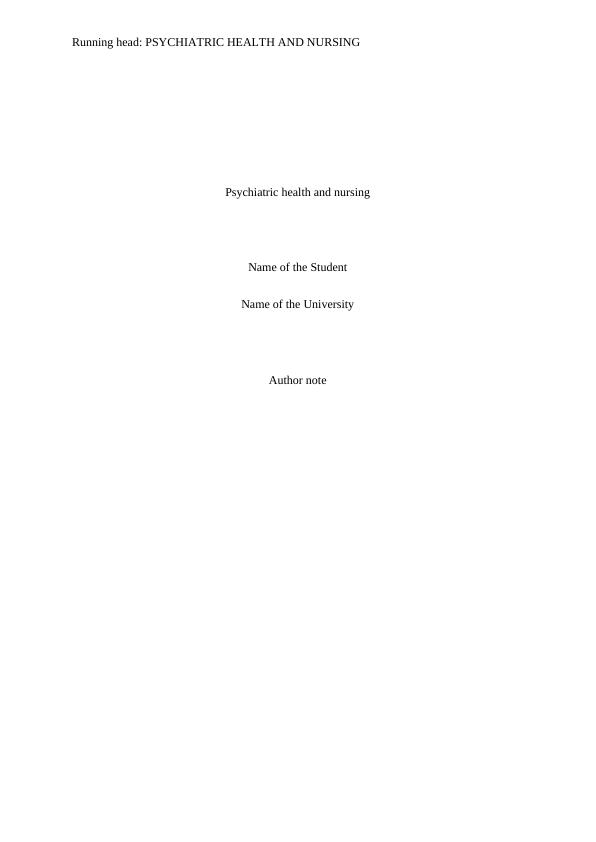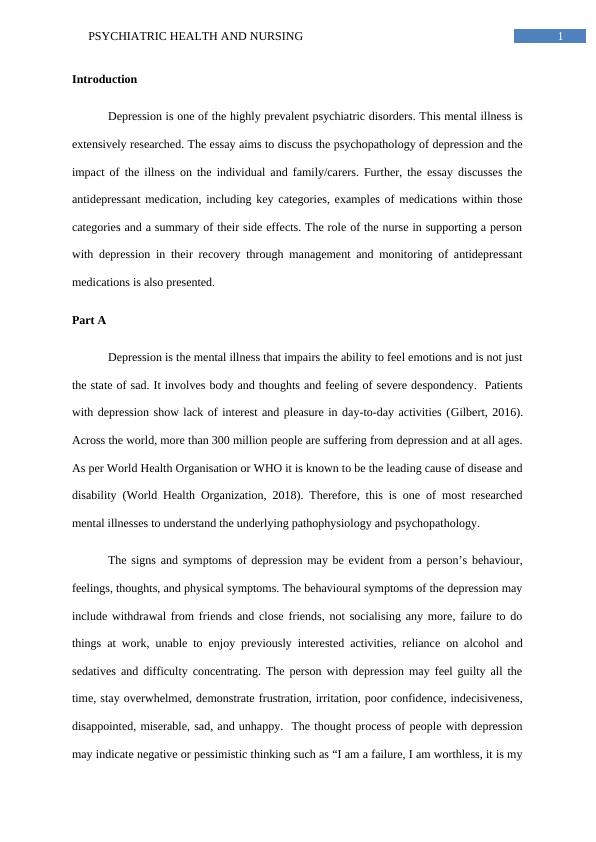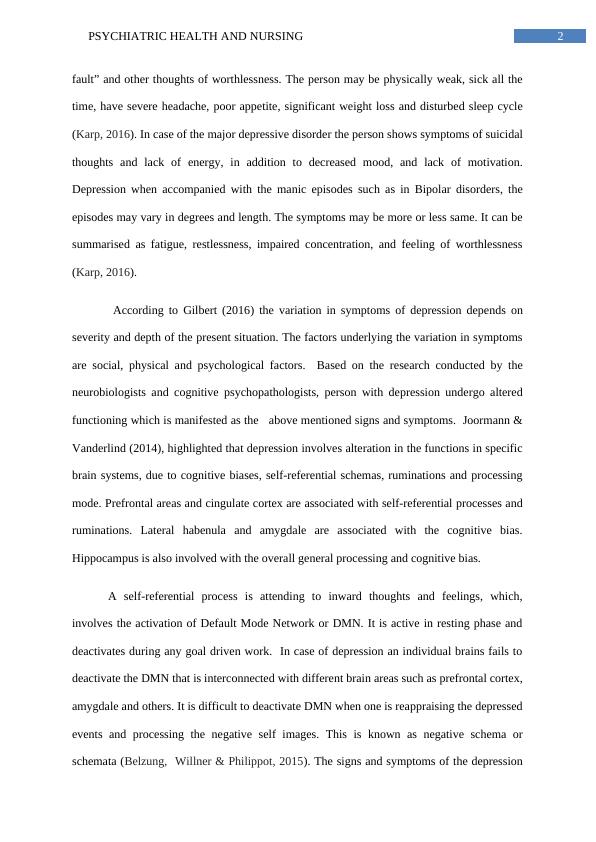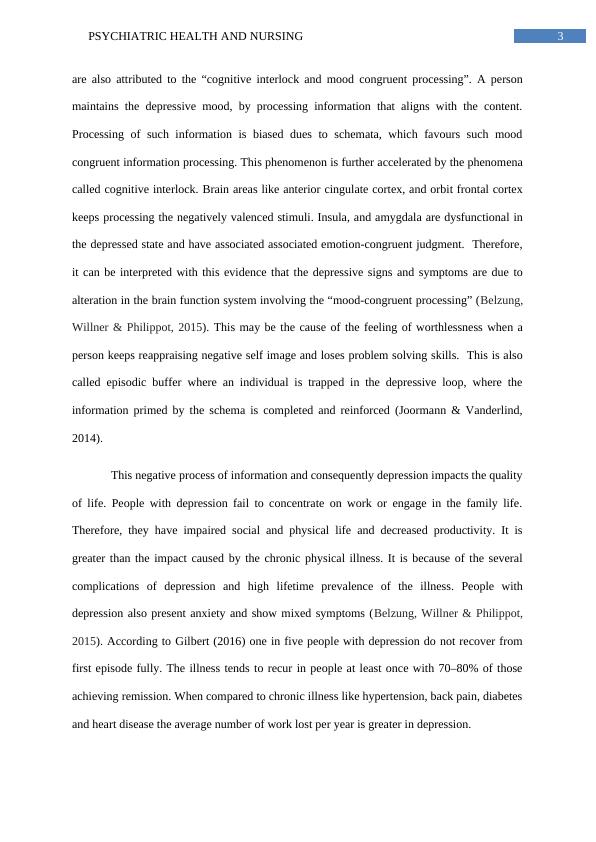Psychiatric Health and Nursing: Understanding Depression and Antidepressant Medications
Added on 2023-06-12
12 Pages3453 Words318 Views
Running head: PSYCHIATRIC HEALTH AND NURSING
Psychiatric health and nursing
Name of the Student
Name of the University
Author note
Psychiatric health and nursing
Name of the Student
Name of the University
Author note

1PSYCHIATRIC HEALTH AND NURSING
Introduction
Depression is one of the highly prevalent psychiatric disorders. This mental illness is
extensively researched. The essay aims to discuss the psychopathology of depression and the
impact of the illness on the individual and family/carers. Further, the essay discusses the
antidepressant medication, including key categories, examples of medications within those
categories and a summary of their side effects. The role of the nurse in supporting a person
with depression in their recovery through management and monitoring of antidepressant
medications is also presented.
Part A
Depression is the mental illness that impairs the ability to feel emotions and is not just
the state of sad. It involves body and thoughts and feeling of severe despondency. Patients
with depression show lack of interest and pleasure in day-to-day activities (Gilbert, 2016).
Across the world, more than 300 million people are suffering from depression and at all ages.
As per World Health Organisation or WHO it is known to be the leading cause of disease and
disability (World Health Organization, 2018). Therefore, this is one of most researched
mental illnesses to understand the underlying pathophysiology and psychopathology.
The signs and symptoms of depression may be evident from a person’s behaviour,
feelings, thoughts, and physical symptoms. The behavioural symptoms of the depression may
include withdrawal from friends and close friends, not socialising any more, failure to do
things at work, unable to enjoy previously interested activities, reliance on alcohol and
sedatives and difficulty concentrating. The person with depression may feel guilty all the
time, stay overwhelmed, demonstrate frustration, irritation, poor confidence, indecisiveness,
disappointed, miserable, sad, and unhappy. The thought process of people with depression
may indicate negative or pessimistic thinking such as “I am a failure, I am worthless, it is my
Introduction
Depression is one of the highly prevalent psychiatric disorders. This mental illness is
extensively researched. The essay aims to discuss the psychopathology of depression and the
impact of the illness on the individual and family/carers. Further, the essay discusses the
antidepressant medication, including key categories, examples of medications within those
categories and a summary of their side effects. The role of the nurse in supporting a person
with depression in their recovery through management and monitoring of antidepressant
medications is also presented.
Part A
Depression is the mental illness that impairs the ability to feel emotions and is not just
the state of sad. It involves body and thoughts and feeling of severe despondency. Patients
with depression show lack of interest and pleasure in day-to-day activities (Gilbert, 2016).
Across the world, more than 300 million people are suffering from depression and at all ages.
As per World Health Organisation or WHO it is known to be the leading cause of disease and
disability (World Health Organization, 2018). Therefore, this is one of most researched
mental illnesses to understand the underlying pathophysiology and psychopathology.
The signs and symptoms of depression may be evident from a person’s behaviour,
feelings, thoughts, and physical symptoms. The behavioural symptoms of the depression may
include withdrawal from friends and close friends, not socialising any more, failure to do
things at work, unable to enjoy previously interested activities, reliance on alcohol and
sedatives and difficulty concentrating. The person with depression may feel guilty all the
time, stay overwhelmed, demonstrate frustration, irritation, poor confidence, indecisiveness,
disappointed, miserable, sad, and unhappy. The thought process of people with depression
may indicate negative or pessimistic thinking such as “I am a failure, I am worthless, it is my

2PSYCHIATRIC HEALTH AND NURSING
fault” and other thoughts of worthlessness. The person may be physically weak, sick all the
time, have severe headache, poor appetite, significant weight loss and disturbed sleep cycle
(Karp, 2016). In case of the major depressive disorder the person shows symptoms of suicidal
thoughts and lack of energy, in addition to decreased mood, and lack of motivation.
Depression when accompanied with the manic episodes such as in Bipolar disorders, the
episodes may vary in degrees and length. The symptoms may be more or less same. It can be
summarised as fatigue, restlessness, impaired concentration, and feeling of worthlessness
(Karp, 2016).
According to Gilbert (2016) the variation in symptoms of depression depends on
severity and depth of the present situation. The factors underlying the variation in symptoms
are social, physical and psychological factors. Based on the research conducted by the
neurobiologists and cognitive psychopathologists, person with depression undergo altered
functioning which is manifested as the above mentioned signs and symptoms. Joormann &
Vanderlind (2014), highlighted that depression involves alteration in the functions in specific
brain systems, due to cognitive biases, self-referential schemas, ruminations and processing
mode. Prefrontal areas and cingulate cortex are associated with self-referential processes and
ruminations. Lateral habenula and amygdale are associated with the cognitive bias.
Hippocampus is also involved with the overall general processing and cognitive bias.
A self-referential process is attending to inward thoughts and feelings, which,
involves the activation of Default Mode Network or DMN. It is active in resting phase and
deactivates during any goal driven work. In case of depression an individual brains fails to
deactivate the DMN that is interconnected with different brain areas such as prefrontal cortex,
amygdale and others. It is difficult to deactivate DMN when one is reappraising the depressed
events and processing the negative self images. This is known as negative schema or
schemata (Belzung, Willner & Philippot, 2015). The signs and symptoms of the depression
fault” and other thoughts of worthlessness. The person may be physically weak, sick all the
time, have severe headache, poor appetite, significant weight loss and disturbed sleep cycle
(Karp, 2016). In case of the major depressive disorder the person shows symptoms of suicidal
thoughts and lack of energy, in addition to decreased mood, and lack of motivation.
Depression when accompanied with the manic episodes such as in Bipolar disorders, the
episodes may vary in degrees and length. The symptoms may be more or less same. It can be
summarised as fatigue, restlessness, impaired concentration, and feeling of worthlessness
(Karp, 2016).
According to Gilbert (2016) the variation in symptoms of depression depends on
severity and depth of the present situation. The factors underlying the variation in symptoms
are social, physical and psychological factors. Based on the research conducted by the
neurobiologists and cognitive psychopathologists, person with depression undergo altered
functioning which is manifested as the above mentioned signs and symptoms. Joormann &
Vanderlind (2014), highlighted that depression involves alteration in the functions in specific
brain systems, due to cognitive biases, self-referential schemas, ruminations and processing
mode. Prefrontal areas and cingulate cortex are associated with self-referential processes and
ruminations. Lateral habenula and amygdale are associated with the cognitive bias.
Hippocampus is also involved with the overall general processing and cognitive bias.
A self-referential process is attending to inward thoughts and feelings, which,
involves the activation of Default Mode Network or DMN. It is active in resting phase and
deactivates during any goal driven work. In case of depression an individual brains fails to
deactivate the DMN that is interconnected with different brain areas such as prefrontal cortex,
amygdale and others. It is difficult to deactivate DMN when one is reappraising the depressed
events and processing the negative self images. This is known as negative schema or
schemata (Belzung, Willner & Philippot, 2015). The signs and symptoms of the depression

3PSYCHIATRIC HEALTH AND NURSING
are also attributed to the “cognitive interlock and mood congruent processing”. A person
maintains the depressive mood, by processing information that aligns with the content.
Processing of such information is biased dues to schemata, which favours such mood
congruent information processing. This phenomenon is further accelerated by the phenomena
called cognitive interlock. Brain areas like anterior cingulate cortex, and orbit frontal cortex
keeps processing the negatively valenced stimuli. Insula, and amygdala are dysfunctional in
the depressed state and have associated associated emotion-congruent judgment. Therefore,
it can be interpreted with this evidence that the depressive signs and symptoms are due to
alteration in the brain function system involving the “mood-congruent processing” (Belzung,
Willner & Philippot, 2015). This may be the cause of the feeling of worthlessness when a
person keeps reappraising negative self image and loses problem solving skills. This is also
called episodic buffer where an individual is trapped in the depressive loop, where the
information primed by the schema is completed and reinforced (Joormann & Vanderlind,
2014).
This negative process of information and consequently depression impacts the quality
of life. People with depression fail to concentrate on work or engage in the family life.
Therefore, they have impaired social and physical life and decreased productivity. It is
greater than the impact caused by the chronic physical illness. It is because of the several
complications of depression and high lifetime prevalence of the illness. People with
depression also present anxiety and show mixed symptoms (Belzung, Willner & Philippot,
2015). According to Gilbert (2016) one in five people with depression do not recover from
first episode fully. The illness tends to recur in people at least once with 70–80% of those
achieving remission. When compared to chronic illness like hypertension, back pain, diabetes
and heart disease the average number of work lost per year is greater in depression.
are also attributed to the “cognitive interlock and mood congruent processing”. A person
maintains the depressive mood, by processing information that aligns with the content.
Processing of such information is biased dues to schemata, which favours such mood
congruent information processing. This phenomenon is further accelerated by the phenomena
called cognitive interlock. Brain areas like anterior cingulate cortex, and orbit frontal cortex
keeps processing the negatively valenced stimuli. Insula, and amygdala are dysfunctional in
the depressed state and have associated associated emotion-congruent judgment. Therefore,
it can be interpreted with this evidence that the depressive signs and symptoms are due to
alteration in the brain function system involving the “mood-congruent processing” (Belzung,
Willner & Philippot, 2015). This may be the cause of the feeling of worthlessness when a
person keeps reappraising negative self image and loses problem solving skills. This is also
called episodic buffer where an individual is trapped in the depressive loop, where the
information primed by the schema is completed and reinforced (Joormann & Vanderlind,
2014).
This negative process of information and consequently depression impacts the quality
of life. People with depression fail to concentrate on work or engage in the family life.
Therefore, they have impaired social and physical life and decreased productivity. It is
greater than the impact caused by the chronic physical illness. It is because of the several
complications of depression and high lifetime prevalence of the illness. People with
depression also present anxiety and show mixed symptoms (Belzung, Willner & Philippot,
2015). According to Gilbert (2016) one in five people with depression do not recover from
first episode fully. The illness tends to recur in people at least once with 70–80% of those
achieving remission. When compared to chronic illness like hypertension, back pain, diabetes
and heart disease the average number of work lost per year is greater in depression.

End of preview
Want to access all the pages? Upload your documents or become a member.
Related Documents
Psychopathology: Understanding and Treating Psychological Disorderslg...
|15
|890
|165
Psychopathological Condition Essaylg...
|10
|2631
|36
Therapeutics of Depressive Illness | Reportlg...
|14
|3756
|21
THERAPEUTICS OF DEPRESSIVE ILLNESSlg...
|14
|3754
|20
Medical Anthropologylg...
|7
|1572
|290
Mental health- nursing contents | Assignmentlg...
|13
|2595
|25
